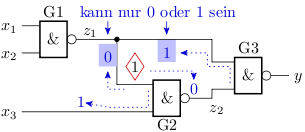Lehre.TestDep (Struktur)
Test und Dependability (3V1Ü)
|
(G. Kemnitz) IT systems automate intellectual tasks: operational procedures control of processes and machines, design tasks, ... The basic requirement for use is dependability. |

|
Key to this are checks and the
and the elimination of detected deficiencies on three levels::
Target audience of the lecture: Master of Computer Science and interested students from other degree programmes Credits: (ECTS): 6
|
Slide sets [dt]
[S] -- Slide sets, [H] -- Handouts for printing.- [S1] Hazards, countermeasures and parameters
- Introduction
- Dependability: service model, availability, reliability, safety.
- Dealing with malfunctions: Monitoring, format checks, value checks, handling of detected malfunctions, dependability improvement.
- Fault elimination: Elimination iteration, Fault diagnosis and isolation, Test, stuck-at faults, reliability improvement, maturing processes, modular test, yield and defect level.
- Fault prevention: fault emergence, determinism and randomness, projects and process models, quality and creativity.
- [S2] Probabilities
- Probabilities: definition and estimation, chained events, fault tree analysis, Markov chains.
- Fault detection: without and with memory, fault modelling.
- Troubleshooting: replacement, repair, maturing processes.
- Fault emergence.
- [S3] Distributions
- Distribution: Characteristics, Linear transformation, distribution of counts
- Approximations for count distributions: Binomial distribution, Poisson distribution, Range estimation for Poisson distributed random variables, normal distribution, Range estimation for normally distributed random variables, variance increase, Range estimation with dependencies.
- Mixed distribution: properties, applications, range estimates with Chebyshev's inequality.
- Pareto distribution: properties, fault detection length, damage due to malfunctions.
- Gamma and exponential distribution
- Failures: Parameters, pre-ageing, reserve units, maintenance.
- Tests and checks
- Test: inspection, function test, digital circuits, software, printed circuit boards.
- Monitoring: comparison, information redundancy, fault detecting codes, check indicators, protocols, time monitoring, invariants, syntax.
- Fault tolerance: error-correcting codes, RAID and backup, redundancy, system solutions.
-
Circuit test and self-test
- Fault modelling: circuit faults, local faults, fault models for digital circuits, detection relationships.
- Tests search: Fault simulation, D-algorithm, implication test, search space structuring, complex function blocks, sequential circuits, memory test.
- Self-test: pseudo-random register, signature register, self-test with LFSR, fault-oriented weighting, RAM self-test.
-
Software
- Programming language: data objects, control flow, malfunction handling, test.
- Design process: Software architecture, design flow, testable requirements, coding and testing..
- Test selection: Mutations, control flow, def-use chains, equivalence classes, UW graph, automata.
- Exercises
References
- G. Kemnitz: Test und Verlässlichkeit von Rechnern. Springer, 2007
- P. Liggesmeyer: Software-Qualität. Spektrum, 2002
- G. Becker: Softwarezuverlässigkeit. deGryter, 1989
- K. Heidtmann. Zuverlässigkeitsbewertung technischer Systeme. Teubner, 1997
- R. Kärger: Diagnose von Computern. Teubner, 1996
- Glerum et al.: Debugging in the (Very) Large: Ten Years of Implementation and Experience.
News:
Autor: gkemnitz, Letzte Änderung: 06.11.2024 20:33:30
TU Clausthal 2020 Impressum
